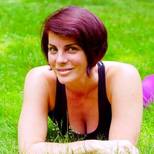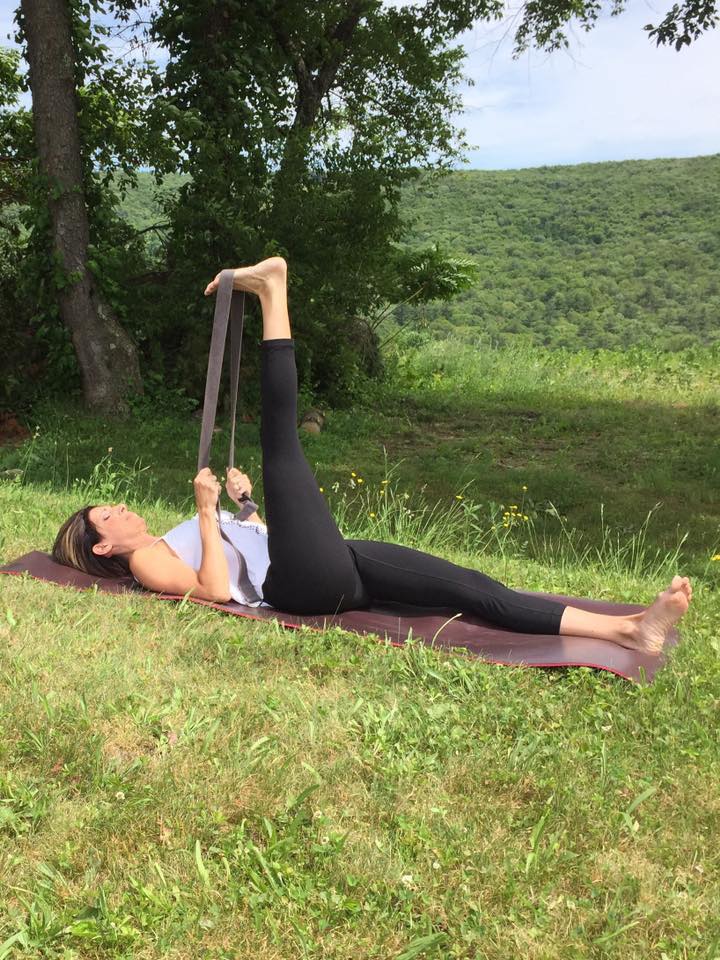|
Not all stretch is created equal. There are several factors that can support stretch and depending on your currently level of mobility some might work better for you than others. The short story is there are essentially 4 main components to stretch that when mixed in different ways add a different utility to the poses and encourage different results. 4 Components of Stretch Below we have listed some stretching vocabulary and techniques. There are many “methods” and “brands” of stretching, but all movement cobines these elements to create a specific way to invigorate and release the tissues of the body. Static Stretching (No Motion) Static stretching means a stretch is held in a challenging but comfortable position for a period of time, usually somewhere between 15 to 30 seconds. In the case of some styles of static yoga stretches they may be held from 30 second up to 2 minutes or more. Static stretching is considered safe and effective for improving overall flexibility. However, we may consider that static stretching may be much less beneficial than dynamic stretching for improving range of motion for functional movement, including sports and daily activities. Dynamic Stretching (Motion) Dynamic stretching means a stretch is performed by moving through a challenging but comfortable range of motion repeatedly, usually 10 to 12 times. Although dynamic stretching might feel more challenging to some students as it requires more coordination than static stretching (because of the movement involved). Note that dynamic stretching should not be confused with bouncing or ballistic stretching. Dynamic stretching is purposful, smooth, and deliberate, whereas bouncing stretching is uncontrolled, erratic, and jerky. The risks that may occur in a bouncing stretch far out way the rewards. Controlled moments lend stability and therefore decrease the chance of injury. Flow Yoga works in continuous motion in a dynamic way. Passive Stretching (No muscular contraction at that joint) Passive stretching means you’re using some sort of outside assistance such as body weight, a strap, leverage, gravity, another person, or a stretching device to help you achieve a stretch. With passive stretching, you relax the muscle you’re trying to stretch and rely on the external force to hold you in place. Effort in a passive stretch should be minimal. Please use caution as there is always the risk that the external force will be stronger than you are flexible, which could cause injury. Active Stretching (Muscular contraction of the opposite side to facilitate stretch) Active stretching means you’re stretching a muscle by consciously contracting the muscle in opposition to the one you’re stretching without the use your body weight, a strap, leverage, gravity, another person, or a stretching device. With active stretching, you relax the muscle you’re trying to stretch and rely on the opposing muscle to initiate the stretch or you are working with an eccentric contraction where the muscle is trying to contract as it is lengthening. Active stretching can be challenging because of the muscular force required to generate the stretch but is generally considered lower risk because you are controlling the stretch force with your own strength rather than an external force. ____________________________________________________________ In Addition to these 4 component/ types of stretch there are 2 more techniques of stretch that movement professionals will consider. They are Isometric and PNF. Isometric Stretching- This type of stretching is Static. It alternated between and active engagement of the muscle being stretched and relaxing the muscle you are trying to stretch. For example if you are in a seated forward fold hold it for a few minutes you would alternate between contracting and releasing the hamstrings and calves while in the pose. PNF (Proprioceptive Neuromuscular Facilitation)- This style of stretching requires a partner of a facilitator and acts similarly to Isometric Stretching. PNF stretching most effective way known to increase static-passive flexibility. PNF is an acronym for proprioceptive neuromuscular facilitation. It is not really a type of stretching but is a technique of combining passive stretching and isometric stretching in order to achieve maximum static flexibility. Example: Supine One Leg Hamstring Stretch: The receiver would press into the facilitators hand with the back of their leg to create resistance engaging the hamstrings. When the receiver releases the contraction and the muscle becomes passive, the facilitator will keep the resistance on the limb guiding it deeper into the pose. This alternating contraction and release may go 3-5 rounds. Types of Yoga currently offered at Boundless Yoga Studio and How stretch applies. (Schedule is subject to change and can be found HERE) RESTORATIVE YOGA (Static/ Passive) - Passive, relaxed positions using full support and gravity to gently open the body in comfortable positions. Great to release stress and go within. 7:00 am WED Gentle Yoga (also included some basic flow) w/ Kate Deangelo 7:15 pm THURS Body, Mind Meditation- Restorative Yoga w/ Karen Iracane YIN YOGA and ALIGNMENT CLASSES (Combination Static/ Active and Static Passive)- These classes use longer held positions often with active engagement to facilitate a deeper opening in the myofascia. * Yin classes are more seated and supine poses good for overall range of motion. Alignment classes will work the full spectrum of postures and do not hold the poses as long as the Yin style. Easy to adapt to all levels of practice. 9:30 am MON Hatha/ Align w/ Chris Loebsack 5:30 pm TUES ( L0-1) Beginners Plus (may also add some flow) w/ Devon Blakely 8:15 am WED YIN w/ Tracy Gross 8:15 am FRI YIN w/ Tracy Gross FLOW or VINYASA CLASSES- (Dynamic/ Active) These classes work the muscles through their full range of motion while moving fairly consistently. Example- Sun Salutations. Great for students who like to move. 8:15 am MON Open Level Flow 5:30 pm MON Level 1-2 Zen Flow 9:30 am TUES Open Level Flow 5:30 pm WED Open Level Flow 7:15 pm WED Brand new Beginner Flow 9:30 am THURS Progressions to Expressions (Moderate to experienced practitioners) 5:30 pm THURS (MAY 9th-30th, 2019) Introduction to AcroYoga- Partner Practice 9:30 pm FRI Yoga Conditioning Open Level 9:30 am SUN Level 1-2 Flow Many classes to some degree will use a little bit of all types while some classes specialize. YIN Classes will be primarily static/ active while something like our Dynamic Stretch Classes will focus on moving through a comfortable range of motion in a dynamic/active way. Passive assists from teachers will help to encourage the body to find where it can potentially go. Staff NOTE: There are always new classes and more workshop and weekend training offerings on the schedule, we hope you enjoy trying some of our highlighted features. Send us your yoga questions so we can keep Chris busy writing more blogs! [email protected]  About Chris Loebsack Chris Loebsack, 500 E.R.Y.T, fell in love with yoga in 1995 and began teaching in 2003. Chris uses the power of yoga to create a space for students that cultivates trust, playfulness and Divine connection with themselves and with community. Living by her mantra, Clarity, Integrity and Love, she draws upon her partner yoga practice to share the healing power of touch and safe intimacy. A passion for discovering subtlety in movement has lead Chris to deepen her education with the Anatomy Studies for Yoga Teachers® kinesiology program. Her playful yet focused classes are filled with user friendly gems of applied anatomy leaving students with a greater understanding of how to find comfort and space in their bodies and smiles beaming across their faces. She encourages teachers to set a higher standard of excellence through knowledge and has become a valuable mentor to many upcoming yoga educators. Chris teaches privates, classes and workshops across the globe. She is currently the director of the Boundless Yoga 200 hr and 500 hr Teacher Training programs and an Adjunct Teacher Trainer for the Om Factory® School of Yoga NYC 200hr, BambooMoves, Bhakti Barn Yoga, Just Plain Yoga, and NearMe Yoga 200hr Teacher Training Programs. She has also been featured in Fitness Magazine®, Yoga Journal: Yoga Mentor, Good an Well, Local Flair Magazine and the New York Times. In addition to yoga you are likely to find her laughing with friends and family or quietly meditating with her cats (Sukha, Fuzz-butt, and Squirrel) or traveling and teaching with her husband Brian M. Davis as Boundless Motion. Boundless Yoga Studio Classes: Alignment and Anatomy of Yoga (All Levels) Mondays 9:30 am Zen Flow (Level 1/2) Mondays 5:30 pm Flow (Level 2/3 Progressions to expressions) Thursdays 9:30 am (MAY 9th-30th, 2019) Introduction to AcroYoga- Partner Practice 5:30 pm THURS Flow (Level 1) Sundays 9:30 am
0 Comments
Leave a Reply. |
Boundless Yoga Staff & StudentsWe are continuously interested on how our reactions and responses to our personal journeys, albeit travel, adventure, new job, etc. mirror and reflect our social, emotional and spiritual ups and downs. We try every day to apply what we learn about ourselves on the yoga mat to our personal lives. Thank you for tuning in as we share some of those aspects with you. Archives
December 2022
Categories
All
|
- HOME
-
- Monthly Challenge
- Book Club Discussion
- 7/11-8/1 (Thurs) Meditation & Mindful Movement Series
- 7/17 Beach Day Yoga Road Trip: Ocean Groove NJ
- 8/3- 8/28 (Tues): Roll & Release Series
- Sept/Oct: Inversion Immersion
- Sept-Dec: Personal Development Course
- 9/15 Moon Planning Workshop
- Bhakti Flow and Kirtan w/ Ian Froman
- Schedule
-
- 200 Hour Teacher Training
- 300 Hour Teacher Training
- Arm Balance Academy - CE Program
- Inversion Immersion Training Program
- Personal Development- Continuing Studies
- Thai Yoga Training
- The Boundless Breath ~ Pranayama Training Weekend
- The Koshas Demystified - Yoga Philosophy Course
- Rollit & Release it: Yoga and Fascia Continued Studies
- Yin Yoga Basics Course
- Yin Yoga Advanced Course
- Aerial Yoga Teacher Training
- Professional Development Continuing Studies Module
- Boundless Vinyasa Sequencing- Unlock the Power of Combination and Flow
- Aerial Yoga Yin-Restorative Training
- Graduate Directory
- Yoga Online Anytime
- Contact Us
- Blog: Insights from our Staff and Students
- Community Resources
- Studio Rental
- Media and News
- Yoga Podcast: Chats from the Mat w/ Brian M. Davis
- HOME
-
- Monthly Challenge
- Book Club Discussion
- 7/11-8/1 (Thurs) Meditation & Mindful Movement Series
- 7/17 Beach Day Yoga Road Trip: Ocean Groove NJ
- 8/3- 8/28 (Tues): Roll & Release Series
- Sept/Oct: Inversion Immersion
- Sept-Dec: Personal Development Course
- 9/15 Moon Planning Workshop
- Bhakti Flow and Kirtan w/ Ian Froman
- Schedule
-
- 200 Hour Teacher Training
- 300 Hour Teacher Training
- Arm Balance Academy - CE Program
- Inversion Immersion Training Program
- Personal Development- Continuing Studies
- Thai Yoga Training
- The Boundless Breath ~ Pranayama Training Weekend
- The Koshas Demystified - Yoga Philosophy Course
- Rollit & Release it: Yoga and Fascia Continued Studies
- Yin Yoga Basics Course
- Yin Yoga Advanced Course
- Aerial Yoga Teacher Training
- Professional Development Continuing Studies Module
- Boundless Vinyasa Sequencing- Unlock the Power of Combination and Flow
- Aerial Yoga Yin-Restorative Training
- Graduate Directory
- Yoga Online Anytime
- Contact Us
- Blog: Insights from our Staff and Students
- Community Resources
- Studio Rental
- Media and News
- Yoga Podcast: Chats from the Mat w/ Brian M. Davis
Get more updates and fun yoga information on our Facebook page!


 RSS Feed
RSS Feed